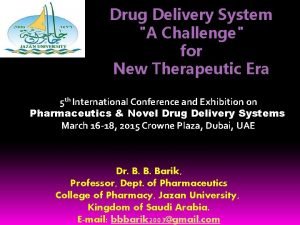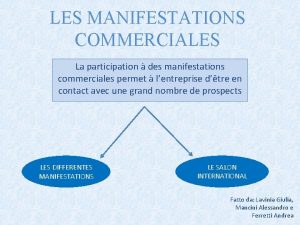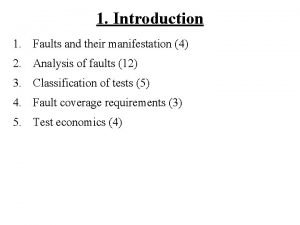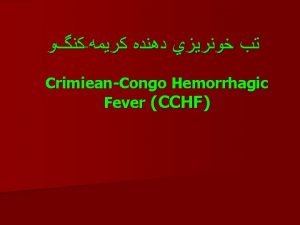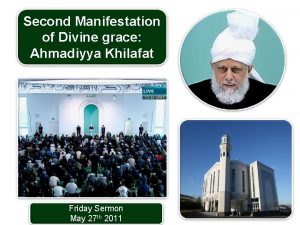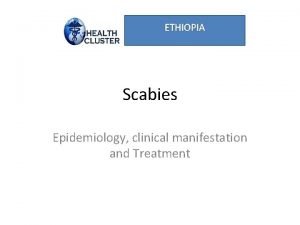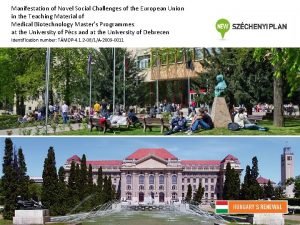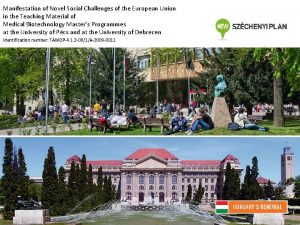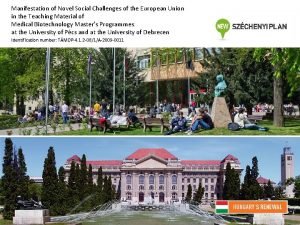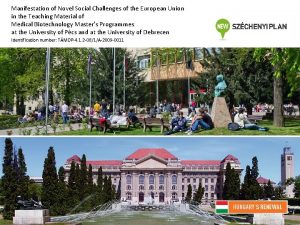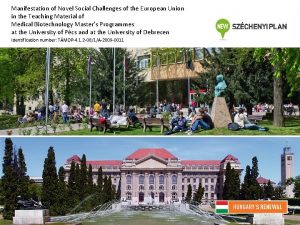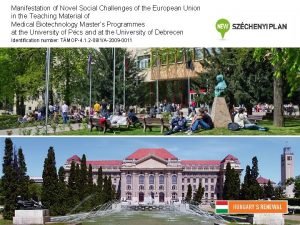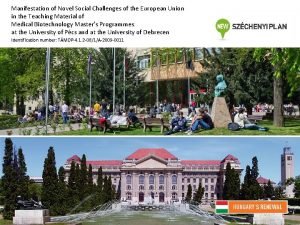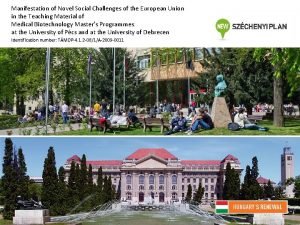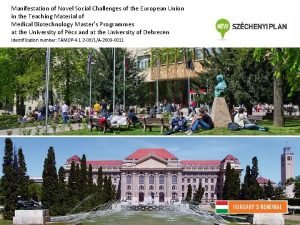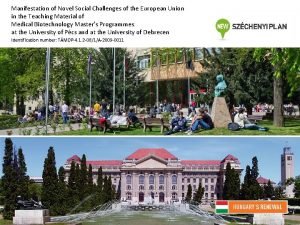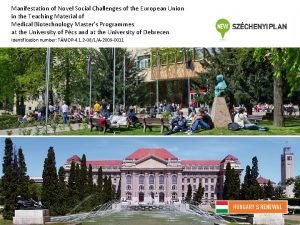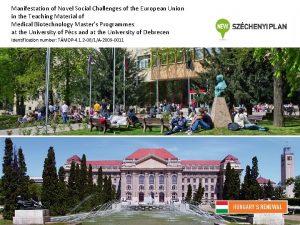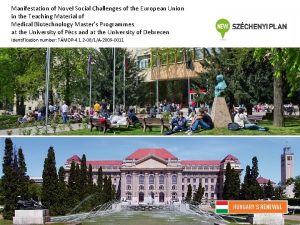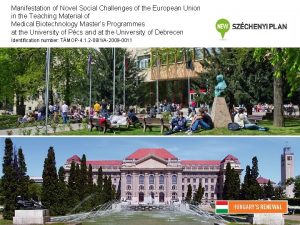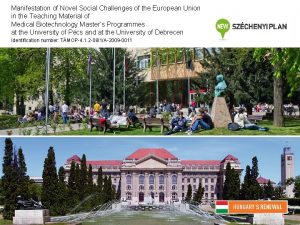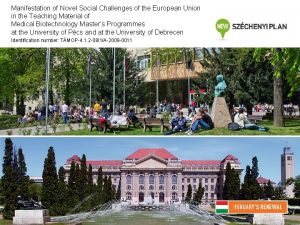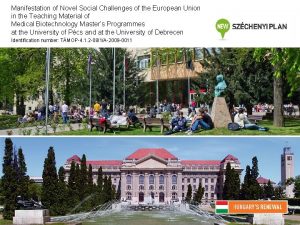Manifestation of Novel Social Challenges of the European



















- Slides: 19

Manifestation of Novel Social Challenges of the European Union in the Teaching Material of Medical Biotechnology Master’s Programmes at the University of Pécs and at the University of Debrecen Identification number: TÁMOP-4. 1. 2 -08/1/A-2009 -0011

Manifestation of Novel Social Challenges of the European Union in the Teaching Material of Medical Biotechnology Master’s Programmes at the University of Pécs and at the University of Debrecen Identification number: TÁMOP-4. 1. 2 -08/1/A-2009 -0011 Krisztián Kvell Molecular and Clinical Basics of Gerontology – Lecture 26 GENETIC BACKGROUND OF LONGEVITY – MOLECULAR MECHANISMS OF INTERVENTION

TÁMOP-4. 1. 2 -08/1/A-2009 -0011 Correlation between body mass and lifespan tmax (yrs) 1000 10 1 1. E+00 y = 5. 58 x 0. 146 r 2 = 0. 340 1. E+02 1. E+04 1. E+06 M (g) 1. E+08 1. E+10

TÁMOP-4. 1. 2 -08/1/A-2009 -0011 Theory of antagonistic pleiotropy • Trade-off between fertility and longevity genes • Optimal conditions: invest in growth and reproduction • Restrictive conditions: shut off reproduction, invest in somatic maintenance and survival

TÁMOP-4. 1. 2 -08/1/A-2009 -0011 The family tree of aging theories Aging theories Evolutionary theories of living and longevity Programmed theories Damage theories Beyond molecular biology of aging • Programmed death theory • Immune system compromise • Thermodynamics of aging • Mutation accumulation theory • Neurological degeneration • Reliability theory • Hormonal theory of aging • Rate of living theory • The antagonistic pleiotropy theory • The genetic clock (programmed epigenomic theory) General formulations • Misrepair accumulation theory • Waste accumulation theory of aging • Error catastrophe theory • Wear and tear theory Individual mechanisms • Chronic or excess infammation • Mitochondrial damage • Methylation • Glycation • Oxidative damage-Free radical • Somatic DNA damage/mutation Stress-induced premature senescence (SIPS)

TÁMOP-4. 1. 2 -08/1/A-2009 -0011 Centenarians • Morbidity rate increase peaks at 60 y, decelerates after 80 y, remains linear after 110 y • Environmental effects are strong: centenarians’ spouses gain >15 years over controls • Three major categories of extreme longevity: survivors, delayers, escapers • Average lifespan: 30% genes, 40% environment, 30% pure luck

TÁMOP-4. 1. 2 -08/1/A-2009 -0011 Correlation of morbidity rates and age 60 Sinusitis Asthma Renal disease Arthritis Diabetes Cancer Cardiac disease % with disease 50 40 30 20 10 0 0 20 40 60 Age (years) 80 100

TÁMOP-4. 1. 2 -08/1/A-2009 -0011 Molecular balance of aging and life-span Intracellular accumulation of random cellular damage Anti-ageing factors Pro-ageing factors Caloric restriction Insulin/IGF-1 signalling Fox. O, Fox. A, HSF-1, SKN TGF- β signalling Cellular degradative pathways JNK signalling p 53 Ageing process Chemical substances (e. g. , resveratrol) TOR signalling Mitochondial respiration Protein synthesis Sirtuins Temperature Lifespan

TÁMOP-4. 1. 2 -08/1/A-2009 -0011 Connection of metabolism and longevity Absent in Ames and Snell dwarfs GH Absent in GHR-KO GHR Reduced levels in Ames and Snell dwarfs and GHR-KO mice Klotho IGF-I Insulin IGF-IR IR IRSs AKT ? Extended longevity Reduced levels in Ames and Snell dwarfs and GHR-KO mice Ligand-induced phosporylation is reduced by Klotho, ressembling findings in dwarf and GHR-KO mice

TÁMOP-4. 1. 2 -08/1/A-2009 -0011 Molecular pathways of aging and lifespan Glucose, amino acids Growth factors AAT INS/IGF-1 PDK e ran b m me a sm Pla Cellular energy PI(3, 4, 5)P 3 AA TSC 1/2 PI(4, 5)P 2 AKT/PKB PTEN Rheb LKB 1 el. F 4 E ROS Protein turnover 4 E-BP S 6 Fox. O TOR Cellular toxins (damaged proteins and organelles) JNK SKN-1 S 6 K SKN-1 Sir 2/ Sirt 1 Fox. O target Mithocondrion TGF-β PI 3 K SGK-1 AMPK/ AKK-2 Resveratrol 14 -3 -3 Autophagy Fox. O p 53 AGEING E 2 F-1 Nucleus Cytoplasm SMK-1 Fox. A/ PHA-4 HSF-1

TÁMOP-4. 1. 2 -08/1/A-2009 -0011 Genes influencing longevity I • DNA stability and repair genes - Poly(ADP-ribose) polymerase (PARP) activity directly correlates with life-span - XPF-ERCC 1 endonuclease, progeriod mutations, secondary and tertiary DNA structures - Sirtuins deacetylate key proteins including p 53 and show direct correlation with metabolism

TÁMOP-4. 1. 2 -08/1/A-2009 -0011 Genes influencing longevity II • Defense against ROS - p 66 Shc (SHC 1) signal transduction of oxidative stress, deletions increase ROS resistance and life-span - Paraoxonase 1 (PON 1) protects LDL from oxidative damage, key in atherosclerosis - Klotho (KL) b-glucuronidase, alleles influence coronary artery disease frequency - Superoxide dismutase (SOD) and catalase (CAT) increased activity increases life-span via ROS capture - Hemochromatosis gene (HFE) alleles influence ROS damage via the Fenton reaction

TÁMOP-4. 1. 2 -08/1/A-2009 -0011 Genes influencing longevity III • Mitochondrial genes - Centenarians (9/11) possess SNP at position 5178 of NADH dehydrogenase subunit 2 gene (ND 2) - Haplogroup cluster frequency differences, U, J, UK, WIX were frequent in aged; whereas H, HV were rare - 150 T polymorphism accumulates in aged, though significantly influenced by SNPs 489 C and 10398 G

TÁMOP-4. 1. 2 -08/1/A-2009 -0011 Longevity genes across animal kingdom Human catalase age-1 Pl 3 -kinase daf-2 daf-16 WRN (glucose metabolism) Insulin-like receptor (glucose metabolism) HNF 3 (transcription factor) WRN (Werner Syndrome) *Known effect on aging Animals with a mutation in the age-1 gene live longer than wild type Proportion Surviving Nematode wild type age-1 1. 0 0. 8 0. 6 0. 4 0. 2 0 10 30 20 Age (day) 40 50

TÁMOP-4. 1. 2 -08/1/A-2009 -0011 Aging genes conserved in animal kingdom Worm gene Yeast gene Human ortholog(s) spg-7 AFG 3 L 2 B 0511. 6 a DBP 3 – F 43 G 9. 1 a IDH 2 IDH 3 A sem-5 HSE 1 – unc-26 INP 53 SYNJ 1, SYNJ 2 F 43 G 9. 1 IDH 1 – rpl-1 9 RPL 19 A RPL 1 9 unc-26 INP 51 SYNJ 1, SYNJ 2 rpl-6 RPL 6 B RPL 6 pdk-1 PKH 2 PDPK 1 rpl-9 RPL 9 A RPL 9 eat-6 PMR 1 – spt-4 SPT 4 SUPT 4 H 1 C 06 E 7. 1 a SAM 1 MAT 1 A, MAT 2 A inf-1 a TIF 1 EIF 4 A 2, EIF 4 A 1 rsks-1 a SCH 9 b RPS 6 KB 1, SGK 2 inf-1 a TIF 2 EIF 4 A 2, EIF 4 A 1 Y 46 H 3 C. 6 SIS 2 – inf-1 TIF 4631 EIF 4 G 1, EIF 4 G 3 pos-1 TIS 11 – let-36 a TOR 1 FRAP 1 erm-1 YGR 1 30 C – W 09 H 1. 5 ADH 1 – rab-10 YPT 6 – T 27 F 7. 3 ALG 12 –

TÁMOP-4. 1. 2 -08/1/A-2009 -0011 Genes affecting age-related diseases • Apolipoprotein E, frequency of Apo. E-e 4 allele is very low among centenarians • Cholesterol ester transferase protein, affects HDL and LDL particle size • Apolipoprotein C, Apo. C 3 promoter CC polymorphism accumulates in centenarians • Microsomal transfer protein (MTP) 493 G 6 T variant is rare in aged • Prolyl isomerase (PIN 1) protein folding chaperone genetic variations affect Alzhemier’s frequency

TÁMOP-4. 1. 2 -08/1/A-2009 -0011 SENS • ‘Strategies for Engineered Negligible Senescence’ (Dr. Aubrey de Grey, Cambridge, UK) • Increase the expected age at death for healthy 55 -year old from 85 to 115 years by 2030 • Mimic negligible senescence observed in Hydra

TÁMOP-4. 1. 2 -08/1/A-2009 -0011 SENS: planned interventions • Intervention to occur at three levels: metabolism, damage, pathology - Clearance of damaged IC and EC protein aggregates - Removal of senescent cells - Telomerase-incompetent stem-cell therapy - Escape mitochondrial mutations via shift to g. DNA

TÁMOP-4. 1. 2 -08/1/A-2009 -0011 Limitations of SENS • Longest life documented: Jeanne Calment, 122 y • Have all questions been addressed? • Aging is not clonal (not cancer), but mosaic • Gradual loss of genome instability is inevitable
 Challenges of novel drug delivery system
Challenges of novel drug delivery system Les sentiments de joie
Les sentiments de joie Manifestation commerciale exemple
Manifestation commerciale exemple Manifestation determination meeting agenda
Manifestation determination meeting agenda Manifestation determination flowchart
Manifestation determination flowchart Manifestation determination flowchart
Manifestation determination flowchart Rayon rubis doré
Rayon rubis doré The manifestation of the holy spirit
The manifestation of the holy spirit 5 niveau de dépendance selon virginia henderson
5 niveau de dépendance selon virginia henderson Manifestation determination definition
Manifestation determination definition Fault is manifestation of
Fault is manifestation of Manifestation names
Manifestation names Hepatomogaly
Hepatomogaly Manifestation names
Manifestation names Clinical manifestation of epistaxis
Clinical manifestation of epistaxis Vocabulaire manifestation
Vocabulaire manifestation Manifestation of sunnatullah
Manifestation of sunnatullah Friday manifestation
Friday manifestation Scabies clinical manifestation
Scabies clinical manifestation Social thinking adalah
Social thinking adalah
